Welcome to UTTAR PRADESHAgra & Mathura
The Iconic City-Agra & Mathura-The City of Sirkrishna
UTTAR PRADESH
Situated in the northern part of India, bordering with the capital of India New Delhi, Uttar Pradesh is one of the most popular and an established tourist destination. Uttar Pradesh is at the heart of India, hence it is also known as The Heartland of India.
Uttar Pradesh is known for its rich culture and tradition. It is home to Ayodhya and Mathura birthplace of Lord Rama,Lord Krishna and Bhgwan Parshuram respectively. Uttar Pradesh attracts many national and international tourists. Taj Mahal, one of the New Seven Wonders of the World in Agra is also located in Uttar Pradesh.
There are different places one can visit in Uttar Pradesh. Agra, Jhansi, Lucknow and Meerut are historical cities famous for their monuments. Mathura, Vrindavan, Gokul, Varanasi, Ayodhya, Gorakhpur and Allahabad are holy cities for Hindus and Kushinagar and Sarnath are important Buddhist places among the main four pilgrimage sites related to the life of Gautama Buddha. Noida is the most developed urban city of Uttar Pradesh.
ITINERARY : DELHI-AGRA-MATHURA-DELHI (1 Day)>>
- No of Days: 1 Day
- Distance & Hours: 235kms - 5 hours
- Tour Starts by : 03:00 am (early morning)
DAY-1 : AGRA
|
DAY-1 : MATHURA
|
AGRA
Agra is a city on the banks of the river Yamuna in the northern state of Uttar Pradesh, India. Agra is one of the most populous cities in Uttar Pradesh, and the 24th most populous in India. Agra is a major tourist destination because of its many Mughal-era buildings, most notably the Taj Mahal, Agra Fort and Fatehpur Sikri, all of which are UNESCO World Heritage Sites.
Agra is included on the Golden Triangle tourist circuit, along with Delhi and Jaipur; and the Uttar Pradesh Heritage Arc, tourist circuit of UP state, along Lucknow and Varanasi. Agra falls within the Braj cultural region. The region around the modern city was first mentioned in the epic Mahabharata, where it was called Agrevana "the border of the forest".
Places to Visit in Agra with Short Descriptions:
Taj Mahal

The Taj Mahal meaning "Crown of the Palaces" is an ivory-white marble mausoleum on the south bank of the Yamuna river in the Indian city of Agra, one of the universally admired masterpieces of the world's heritage. It was commissioned in 1632 by the Mugal emperor , Shah Jahan (reigned from 1628 to 1658), to house the tomb of his favourite wife, Muntaz Mahal , a Persian princess who died giving birth to their 14th child, Gauhara Begum. The imperial court documenting Shah Jahan's grief after the death of Mumtaz Mahal illustrates the love story held as the inspiration for the Taj Mahal. It also houses the tomb of Shah Jahan, the builder. The tomb is the centerpiece of a 17-hectare (42-acre) complex, which includes a mosque and a guest house, and is set in formal gardens bounded on three sides by a crenellated wall.
The construction project employed some 20,000 artisans under the guidance of a board of architects led by the court architect to the emperor, Ustad Ahmad Lahouri. Construction of the mausoleum was essentially completed in 1643 but work continued on other phases of the project for another 10 years. The Taj Mahal complex is believed to have been completed in its entirety in 1653 at a cost estimated at the time to be around 32 million rupees, which in 2015 would be approximately 52.8 billion rupees (US $ 827 millions).
The Taj Mahal was designated as a UNESCO World Heritage Site in 1983 for being "the jewel of Muslim art in India and one of the universally admired masterpieces of the world's heritage". It is regarded by many as the best example of Mughal architecture and a symbol of India's rich history. The Taj Mahal attracts 7–8 million visitors a year, it was declared a winner of the NEW 7Wonders of the World (2000–2007) initiative.
Taj Mahal Architecture::
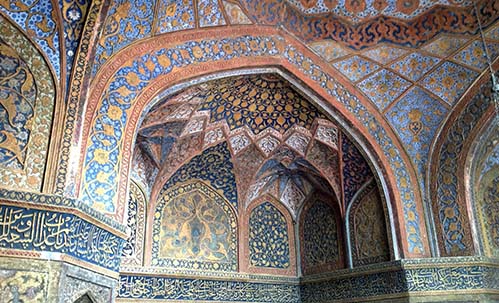
The Taj Mahal is considered to be the greatest architectural achievement in the whole range of Indo-Islamic architecture. Its recognized architectonic beauty has a rhythmic combination of solids and voids, concave and convex and light shadow; such as arches and domes further increases the aesthetic aspect. The color combination of lush green scape reddish pathway and blue sky over it show cases the monument in ever changing tints and moods. The relief work in marble and inlay with precious and semi precious stones make it a monument apart.
The uniqueness of Taj Mahal lies in some truly remarkable innovations carried out by the horticulture planners and architects of Shah Jahan. One such genius planning is the placing of tomb at one end of the quadripartite garden rather than in the exact centre, which added rich depth and perspective to the distant view of the monument. It is also, one of the best examples of raised tomb variety. The tomb is further raised on a square platform with the four sides of the octagonal base of the minarets extended beyond the square at the corners.
The top of the platform is reached through a lateral flight of steps provided in the centre of the southern side. The ground plan of the Taj Mahal is in perfect balance of composition, the octagonal tomb chamber in the centre, encompassed by the portal halls and the four corner rooms. The plan is repeated on the upper floor. The exterior of the tomb is square in plan, with chamfered corners.
Tajmahal tombs
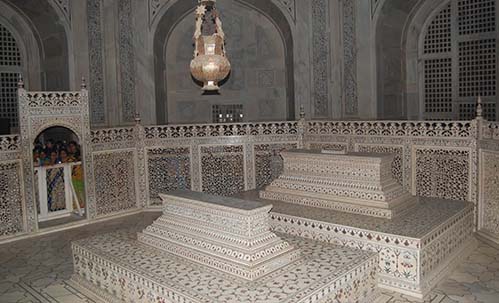
The large double storied domed chamber, which houses the cenotaphs of Mumtaz Mahal and Shah Jahan, is a perfect octagon in plan. The exquisite octagonal marble lattice screen encircling both cenotaphs is a piece of superb workmanship. It is highly polished and richly decorated with inlay work. The borders of the frames are inlaid with precious stones representing flowers executed with wonderful perfection.
The hues and the shades of the stones used to make the leaves and the flowers appear almost real. The cenotaph of Mumtaz Mahal is in perfect centre of the tomb chamber, placed on a rectangular platform decorated with inlaid flower plant motifs. The cenotaph of Shah Jahan is greater than Mumtaz Mahal and installed more than thirty years later by the side of the latter on its west. The upper cenotaphs are only illusory and the real graves are in the lower tomb chamber (crypt), a practice adopted in the imperial Mughal tombs.
The four free-standing minarets at the corners of the platform added a hitherto unknown dimension to the Mughal architecture. The four minarets provide not only a kind of spatial reference to the monument but also give a three dimensional effect to the edifice.
The most impressive in the Taj Mahal complex next to the tomb, is the main gate which stands majestically in the centre of the southern wall of the forecourt. The gate is flanked on the north front by double arcade galleries. The garden in front of the galleries is subdivided into four quarters by two main walk-ways and each quarters in turn subdivided by the narrower cross-axial walkways, on the Timurid-Persian scheme of the walled in garden. The enclosure walls on the east and west have a pavilion at the centre.
The Taj Mahal is a perfect symmetrical planned building, with an emphasis of bilateral symmetry along a central axis on which the main features are placed. The building material used is brick-in-lime mortar veneered with red sandstone and marble and inlay work of precious/semi precious stones. The mosque and the guest house in the Taj Mahal complex are built of red sandstone in contrast to the marble tomb in the centre.
Both the buildings have a large platform over the terrace at their front. Both the mosque and the guest house are the identical structures. They have an oblong massive prayer hall consist of three vaulted bays arranged in a row with central dominant portal. The frame of the portal arches and the spandrels are veneered in white marble. The spandrels are filled with flowery arabesques of stone intarsia and the arches bordered with rope molding.
Agra Fort
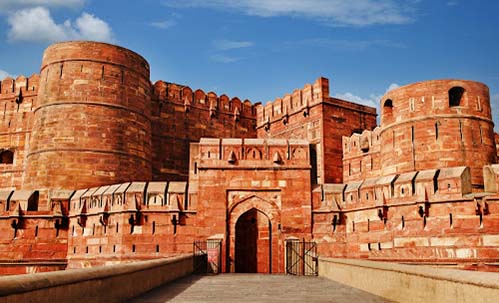
The Agra Fort, also known as the “Lal –Qila”, “Fort Rouge” or “Qila-i-Akbari”, is the highlight of the city of Agra covered in 94 acres, then capital of the Mughal Sultanate. It was the main residence of the emperors of the Mughal Dynasty until 1638, when the capital was shifted from Agra to Delhi.
The Agra fort is a UNESCO World Heritage site.[1] It is about 2.5 km northwest of its more famous sister monument, the Taj Mahal. The fort can be more accurately described as a walled city. The entry to Agra Fort is allowed through the Amar Singh Gate only. Some portion of this fort is used by the Indian Army.
Agra Fort, is attracted to the intricate carvings and the pure marbles that are used in its making. Besides, the breathtaking views of the Yamuna River and Taj Mahal from the balconies of the pavilions will leave you absolutely mesmerized. On visiting the Agra Fort, we will come across Diwan-i-Am or the Hall of Public Audience. This hall with numerous pillars is said to be erected by Shah Jahan in the year 1628. On heading little forward, you will see Royal Pavilions abounding in elegant mosques including Nagina Masjid and Mina Masjid, palaces like Macchi Bhavan, Khas Mahal, Shish Mahal and Shah Jahani Mahal and the Zenana Mina Bazaar.
MATHURA
Mathura is a sacred city in Uttar Pradesh, northern India. Mathura is believed to be the birthplace of Krishna, which is located at the Krishna Janmasthan Temple Complex. It is one of the Sapta Puri, the seven cities considered holy by Hindus. Mathura has an ancient history and also believed to be the homeland and birthplace of Krishna who was born in Yadu dynasty.
The Kesava Deo Temple was built in ancient times on the site of Krishna's birthplace (an underground prison). Mathura was the capital of the kingdom of Surasena, ruled by Kansa, the maternal uncle of Krishna. Dotting the Yamuna River are 25 ghats (flights of steps down to the water), of which Vishram Ghat is considered the holiest. Sati Burj is a 16th-century memorial tower.
Dwarkadhish Temple has a carved entrance and a black-marble idol of Lord Krishna.Fort sits proudly on a ridge of the Aravalli Hills, creating an impressive northern backdrop to the city of Jaipur. It was constructed during the reign of Jai Singh in 1734, and was later expanded in 1868. Mathura has been chosen as one of the heritage cities for Heritage City Development.
Places to Visit in Mathura with Short Descriptions:
Prem Mandir
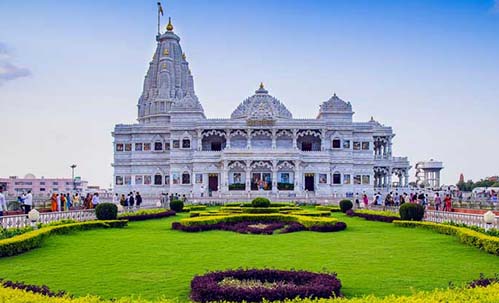
Prem Mandir is a Hindu temple in Vrindavan, Mathura, India. It is maintained by Jagadguru Kripalu Parishat, an international non-profit, educational, spiritual, charitable trust. The complex is on a 54-acre site on the outskirts of Vrindavan, and is dedicated to Lord Radha Krishna and Sita Ram. The temple structure was established by the fifth Jagadguru, Kripalu Maharaj.
Figures of Shri Krishna and his followers depicting important events surrounding the Lord's existence cover the main temple.The foundation stone was laid by Jagadguru Shri Kripalu Ji Maharaj in the presence of thousand devotees on 14 January 2001. It took approximately 1000 artists about 12 years to build the complex.
The Vrindavan site was developed by Kripalu Ji Maharaj, whose main ashram was at Vrindavan. He dedicated the gift of love to Shri Vrindavan Dham. Prem Mandir is constructed entirely of Italian marble. The total dimensions of the temple including its flag is 125 ft. high, 190 ft. long and the 128 ft. wide raised platform serves as the seat of the two-storeyed white monument.
A circumambulation route has been constructed on the mandir prangan, the platform of the temple, enabling visitors to view the 48 panels depicting the pastimes of Shri Radha Krishna which are carved on the outer walls of the temple. The walls are made of solid Italian marble, 3.25 ft. thick. The thickness of the walls of the garbha-griha is 8 ft to bear the weight of huge shikhar, swarna Kalash and the Flag. 84 panels set up on the temple's exterior display the pastimes of Shri Krishna depicted on Shrimad Bhagvatam.
Iskon Vrindavan
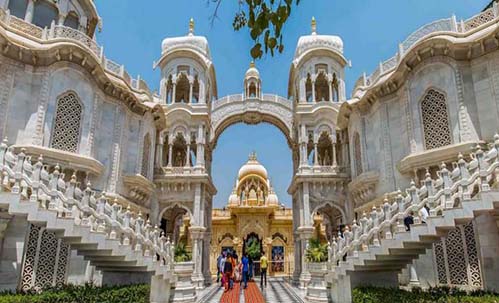
Sri Krishna-Balaram Mandir is a Gaudiya Vaishnava temple in the holy city of Vrindavan. It is one of the main ISKCON temples in India and internationally. The deities of the temple are Krishna and Balarama, at the central altar.
On the right altar are Radha Krishna with Gopi, Lalita and Vishakha. On the left altar is a Murti of Chaitanya Mahaprabhu with Nityananda, and of Bhaktivedanta Swami Prabhupada and his spiritual teacher Bhaktisiddhanta Sarasvati Thakura. Krishna-Balaram Mandir enforces one of the highest standards of cleanliness and of deity worship in all of Vrindavan.
Near the temple, at the entrance to the complex is located samadhi shrine (mausoleum) of Bhaktivedanta Swami Prabhupada, built of pure white marble.
Shree Dwarkadesh Temple
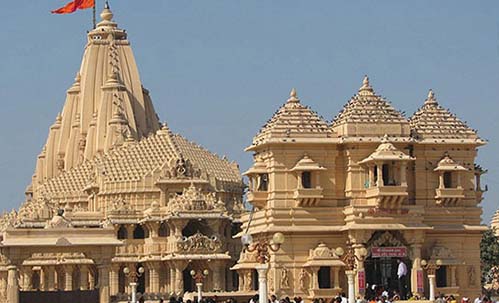
Sri Dwarkadheesh Mandir is one of the oldest and largest temples. This is a major and famous Hindu shrine, and its current structure was built up by Seth Gokul Das Parikh, the treasurer of then Gwalior State (Scindia) in 1814, with approval and heavy donation from Shrimant Daulatrao Scindia Maharajah of Gwalior.
It was built for the famous Hindu deity Dwarkadheesh (meaning the God or king of Dwarka, where Lord Krishna has shifted from Mathura and settled till his life on earth), the main deity, a form of Lord Krishna seen in a black Marble idol named Dwarkanath Along with him the White marble idol of his counterpart deity Rukmini Devi.
The temple is having a good large premises with the main building enclosed by a magnificently carved Rajasthani Style entrance with steep steps leading to temple courtyard. In the central courtyard a platform is built up lined up with three rows of richly carved pillars and support the ceiling which is also beautifully painted. Another small temple of another form of Lord Krishna (vishnu ) Shaligram is also built up within the temple courtyard.
Banke Bihari Temple

Shri Bankey Bihari Mandir is a Hindu temple dedicated to Lord Krishna, in the holy city of Vrindavan in the Mathura district of Uttar Pradesh.Bankey Bihari Temple was established by Swami Haridas (Lalita Sakhi in Dvapara Yuga), a guru of the famous singer Tansen. Bankey Bihari Ji was originally worshipped at Nidhivana. Bankey means "bent in three places" and Bihari means "supreme enjoyer." The image of Lord Krishna stands in the Tribhanga posture. Haridas Swami originally worshipped this devotional image under the name of Kunj-Bihari ("Enjoyer of Lakes").
Banke' means 'bent', and 'Bihari' or 'Vihari' means 'enjoyer'. This is how Krishna, who is bent in three places, got the name "Banke Bihari".
Vishram Ghat
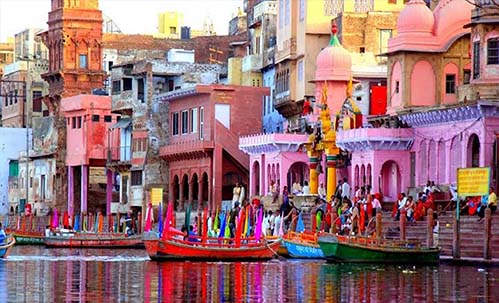
Vishram Ghat is a ghat, a bath and worship place, on the banks of river Yamuna in Mathura, India. It is the main ghat of Mathura and is central to 25 other ghats. The traditional parikrama starts and ends at Vishram Ghat. Lord Krishna is said to have rested at this place after killing Kansa.
Sri Krishna Janmabhoomi
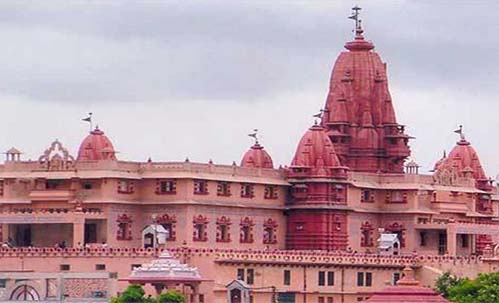
Famed Hindu temple believed to be the location where Lord Shri Krishna first manifested.
